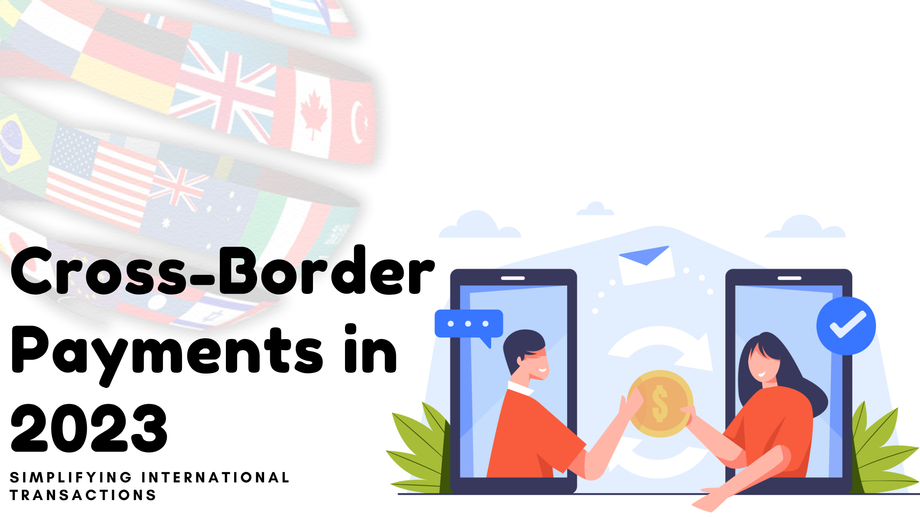The demand to implement successful cross-border payment solutions has never been higher in our increasingly interconnected world, as businesses grow internationally and tourists visit far-flung locales. Cross-border payments are expected to undergo significant changes in 2023, offering both enterprises and travelers simple, safe, and affordable options. We'll examine the difficulties and achievements in cross-border digital payments in this blog, revealing how these changes are influencing how we do international business.
The Importance of Cross-Border Payments Cross-border payments, as the name suggests, refer to financial transactions that occur between individuals, businesses, or financial institutions in different countries. These transactions encompass a wide range of activities, from businesses paying for international suppliers to travelers converting their currency for overseas expenditures.
The importance of smooth and efficient cross-border payments cannot be overstated for several reasons:
- Global Business Expansion
In today's globalized economy, businesses of all sizes are expanding their reach beyond national borders. For multinational corporations, cross-border payments are a daily necessity, as they pay suppliers, employees, and partners in various countries. The efficiency and cost-effectiveness of these transactions can significantly impact a company's bottom line.
- International Trade
The exchange of goods and services between countries relies on cross-border payments. When a company in the United States purchases products from a supplier in China, for example, a cross-border payment must occur to facilitate the transaction. Streamlining these payments can reduce delays and costs associated with international trade.
- Travel and Tourism
For travelers, cross-border payments are essential for funding their adventures abroad. Whether it's booking flights, accommodations, or dining in a foreign country, travelers rely on seamless and secure payment methods to access the services they need while away from home.
- Financial Inclusion
Access to cross-border payment services is crucial for financial inclusion. Immigrants and expatriates depend on these services to send money to their families in their home countries. Simplifying cross-border payments can make financial services more accessible to underserved populations.
The Challenges of Cross-Border Payments Despite the increasing importance of cross-border payments, several challenges have long plagued the industry. These challenges have often made international transactions costly, time-consuming, and cumbersome:
- High Transaction Costs
Traditional cross-border payments can incur high transaction fees, including currency conversion charges and intermediary bank fees. These costs can erode the value of the funds being transferred.
- Slow Processing Times
Cross-border payments have historically been plagued by slow processing times. International wire transfers, for example, may take several days to reach their destination, causing delays in business transactions and financial support for families.
- Currency Exchange Rates
Fluctuating exchange rates can lead to uncertainty in cross-border payments. This can result in unexpected variations in the amount received by the recipient, making financial planning challenging.
- Regulatory
Compliance Stringent anti-money laundering (AML) and know-your-customer (KYC) regulations have increased the compliance burden on financial institutions, contributing to delays and complications in cross-border transactions. Innovations in Cross-Border Payments In response to these challenges, the world of cross-border payments has witnessed remarkable innovations in recent years.
In 2023, several key developments are simplifying international transactions and offering new opportunities for businesses and travelers:
Blockchain Technology: Blockchain, the technology behind cryptocurrencies like Bitcoin, has emerged as a game-changer in cross-border payments. It offers secure and transparent transactions with reduced processing times. Ripple's XRP, for instance, is designed specifically for cross-border payments and has gained traction among financial institutions.
Digital Wallets and Mobile Apps: The rise of digital wallets and mobile payment apps has provided travelers and businesses with convenient tools for cross-border transactions. Services like PayPal, Venmo, and mobile wallets like Apple Pay and Google Pay allow users to make payments and convert currencies effortlessly.
Cryptocurrencies: Cryptocurrencies like Bitcoin, Ethereum, and stablecoins have introduced a decentralized approach to cross-border payments. They offer lower fees and faster transaction times compared to traditional banking systems. Some companies, like BitPay, facilitate cryptocurrency payments for businesses.
Cross-Border Payment Platforms: Fintech companies are launching specialized cross-border payment platforms that simplify international transactions. These platforms often offer competitive exchange rates and lower fees than traditional banks. Examples include TransferWise (now Wise), Revolut, and Payoneer.
Real-Time Payment Systems: Several countries have implemented or are in the process of implementing real-time payment systems that enable instant cross-border transactions. These systems, such as the European Central Bank's TARGET Instant Payment Settlement (TIPS), make cross-border payments as fast as domestic ones.
AI and Machine Learning: Artificial intelligence and machine learning algorithms are being employed to enhance the efficiency of cross-border payments. They help optimize currency conversion and risk management, reducing costs for businesses and individuals.
Regulatory Advances: Regulatory bodies are working to streamline compliance requirements for cross-border payments. Initiatives like the European Union's Single Euro Payments Area (SEPA) and open banking regulations aim to simplify cross-border transactions.
The Future of Cross-Border Payments
As we step into 2023 and beyond, the trajectory of cross-border payments is clear: greater simplicity, speed, and accessibility. Businesses will continue to benefit from cost-effective international transactions, and travelers will enjoy seamless payment experiences abroad.
However, challenges remain, particularly in terms of regulatory harmonization and cybersecurity. To stay ahead in this evolving landscape, it's essential for businesses and individuals to stay informed about the latest developments in cross-border payments. The choice of payment method provider can significantly impact the efficiency and cost of international transactions.
In conclusion, the world of cross-border payments in 2023 is marked by innovations that are simplifying international transactions for businesses and travelers alike. From blockchain technology to real-time payment systems, these advancements promise a future where cross-border payments are faster, more cost-effective, and more accessible than ever before. As we continue to embrace these changes, the global economy becomes more interconnected, and opportunities for growth and exploration expand for all.

